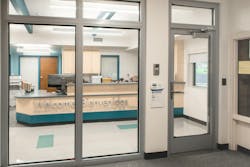How to Bolster Classroom Security with Security-Rated Glazing
As recommended by the Partner Alliance for Safer Schools (PASS) and other organizations, a multilayered approach to safer school design provides multiple fail safes and time barriers to maximize the effectiveness of a comprehensive security plan. These layers stretch from the district level to the classroom perimeter, and each layer plays a significant role in keeping students and faculty safe.
Tactics utilized in these layers include secure entry vestibules, crime prevention through environmental design (CPTED) principles and other features within the property perimeter. The classroom layer, although encountered last by external threats, is often the first barrier between occupants and threats already within a school. As such, classroom security can be as important as hardening the exterior of a building.
Enhancing classroom security involves planning for emergencies with input from security professionals and the specification of code-compliant locking hardware. It can also be achieved through designs that incorporate security-rated glazing systems. While these systems are popular for their ability to pair increased visibility with occupant protection, specification can prove challenging. There are several rating types on the market and no codified standard to follow. This can make it difficult for project stakeholders to know which systems best meet their security goals without compromising code-compliant designs.
Navigating the differences between security-rated glazing types
Security-rated glazing is commonly divided into two general categories: bullet-resistant rated and forced-entry resistant rated. Each category offers different performance capabilities and is tested to different standards. Bullet-resistant glazing measures an assembly’s ability to resist attacks from an array of gun types and bullet calibers. Using the UL 752 standard, third-party labs grade bullet-resistant glazing across eight levels, which correspond to round caliber, shot number and shot placement that a system can defend against without failing. It is important to note the levels do not progress linearly but instead provide performance information that can be used to help specify a system based on the likelihood of a threat.
Forced-entry resistant glazing is meant to slow the forced ingress of intruders by staying intact after a prolonged physical attack. These systems can be tested and certified to ASTM E2395 and HP White 5-aa10 forced-entry standards. Both testing standards are measured in timed increments to provide specifiers and security professionals with data as to how long a system may delay intruders. The intent with forced-entry resistance is to give occupants additional time to contact first responders and take appropriate actions—whether those are evacuation or shelter-in-place.
Once a school’s individual security goals are defined, bullet-resistance ratings and forced-entry resistance ratings can supply enough information to guide most specifications. That said, it is also crucial to understand special considerations, including areas where fire- and life-safety requirements overlap with security best practices.
Solving challenges where multiple life safety considerations overlap
Security-rated glazing is required to be tested to the standard that governs its use. It is not required to be tested to additional standards, such as the fire test. This testing protocol creates challenges when a system is intended to provide multiple forms of protection, such as forced-entry resistance and defense against fire.
When included in a fire-rated system, security-rated glass can compromise or entirely negate an assembly’s fire rating. This is because forced-entry and bullet-resistant components, including security films, are often plastic-based and can burn quickly and intensely. As a result, they may cause situations that surpass fire test parameters, inhibiting the full system’s ability to protect occupants. For this reason, when security goals and building code requirements intersect, specifiers are encouraged to select multifunctional, fire-rated systems that are either tested as a full system or are comprised of compatible components. This reduces the chance of one form of protection negating another.
When it comes to classrooms, being cognizant of fire- and life-safety requirements may impact the use of security-glazing and aftermarket products in classroom door vision lites, sidelites and transoms. For example, Chicago-area schools require any door along exit corridors to be fire-rated, whether or not there is an automatic sprinkler system in place. This means most classroom door assemblies must be fire-rated. In these situations and others like it, using multifunctional, fire-rated glazing systems that incorporate compatible components can help specifiers meet both security goals and code requirements.
Planning for fire and life safety is not just required by code, it is also a part of safer school design. Not only do the PASS K-12 guidelines and recommendations from other organizations highlight the importance of maintaining code compliance while enhancing school safety and security, but the National Fire Protection Association (NFPA) estimates there are over 7,000 fires on school grounds each year, making fire and life safety an important aspect of safer school design.
Architects, school administrators, parent-teacher organizations, security professionals and all other project stakeholders are encouraged then to look at safer school design comprehensively, planning for multiple threats to life safety. Doing so will help create educational settings that are safer and more secure for students, faculty and staff.



